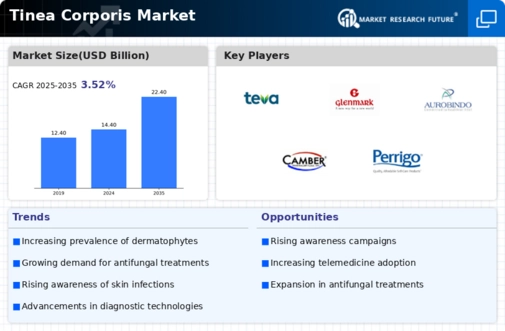Market Share
Tinea Corporis Market Share Analysis
In the Competitive Landscape of the Pharmaceutical Tinea Corporis market, companies are deploying various marketing strategies to gain a strong foothold in treating this dermatologic condition. Differentiation is one such strategy where pharmaceutical firms use unique and effective drug treatments for Tinea Corporis (ringworm) as a fungal infection. These companies would, therefore, want to come up with drugs that are more innovative in terms of efficacy, side-effects minimization or new delivery systems that will give them a specific niche to concentrate on. This will enable them attract clinical professionals on one hand and patients searching for advanced remedies for Tinea Corporis on the other.
Cost leadership is also essential within Pharmaceutical Tinea Corporis Market. Companies are working hard to optimize manufacturing processes, enter into cost-effective raw material contracts and build efficient means of distribution so as to provide affordable treatments. For example, pharmaceuticals tend to be accessible by giving priority to cheapness in relation to their treatment “tinea corporis” which promote general well-being whereas others have chosen cost efficiency as their key message when it comes to tinea corporis treatment hence targeting wide range of patients.
Innovation has a great play in determining the market share in Pharmaceutical Tinea Corporis Market. In this regard, businesses invest in research and development programs aimed at producing novel antifungal agents that will show better effectiveness against ringworm as compared with existing ones. It is through being ahead of changes that these corporations become leaders by earning trust from physicians while enjoying competitive advantages within the industry. Furthermore, these solutions not only keep pace with evolving patient demands but also contribute towards overall progress of dermatological therapies.
Strategic collaborations and partnerships are increasingly prevalent in the Pharmaceutical Tinea Corporis Market. Companies form alliances with research institutions, dermatology clinics and healthcare organizations so as enhance their knowledge base while reaching out wider population groups for clinical trials targeting tinea corporis patients who they collaborate with developing comprehensive treatment approaches for Tinea Corporis. To strengthen their market share and help in the development of dermatological care, companies can build networks of collaborative relationships.
Marketing and branding efforts are instrumental in market share positioning within the Pharmaceutical Tinea Corporis Market. Companies have targeted marketing campaigns designed to raise awareness about Tinea Corporis, educate healthcare providers and promote specific pharmaceutical products. Strong brand presence enhances reputation of a company while gaining trust from healthcare providers thus influencing prescription decisions. Communicating effectively with the target audience is supported by educational initiatives, digital marketing strategies, and participation in dermatology conferences.
Customer-centric strategies are gaining prominence as companies recognize the importance of patient experience in the Pharmaceutical Tinea Corporis Market. For instance, tailoring treatments to suit patients’ specific needs, developing user-friendly topical formulations or offering patient support programs that include such factors as emotional counseling contribute towards gratifying patient experiences. Consequently, drug manufacturers must target not only healthier customers but also those affected by tinea corporis through improving their overall satisfaction levels hence creating customer loyalty as well as generating positive reviews which will enable them enjoy great market shares within highly competitive dermatological pharmaceutical markets.








Leave a Comment